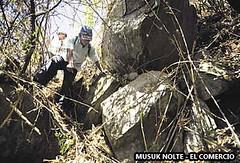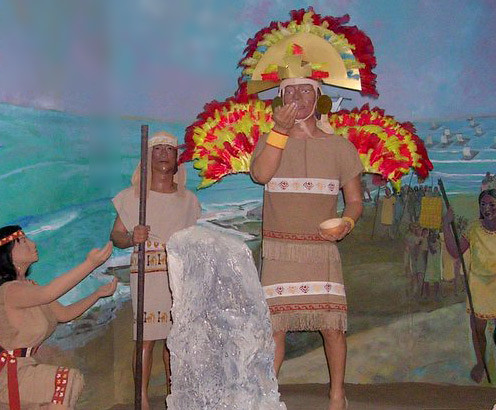In less than two weeks since work began, amazing discoveries have been made at the Cerro Pátapo archaeological site, until now little more than a pile of rocks. This huge site that stretches over 5km is now revealing its importance – it is a missing link between the declining Moche culture and the newly arrived Wari.
Category: "History"
The last of the Taushiros
Peru’s Amazon rainforest has seen the last of the great Taushiro nation. Prospering in the area of the Quebrada Aguaruna in Alto Tigre, Loreto, for thousands of years, the Taushiro, like countless other tribes, have been wiped out by us and our world.
The Nazca Civilisation
Descended from the older Paracas civilisation, the Nazca are of course most famous for their countless mysterious lines draw in the rocky desert plains in which they lived. They were also great water engineers, creating a series of complex aqueducts.
Maria Reiche
…Tirelessly, she spent day after day of her life under the hot sun cleaning rocks from lines, and working on her theories as to what they were for. She for one came to the conclusion that the lines were some kind of calendar, marking solstices and the passage of stars and constellations…
Two Sicán elite found at the Bosque de Pomac archaeological site
New excavations have uncovered two burials of Sicán elite. The co-director of the archaeological project, Carlos Elera Arévalo, explains that the remains of both bodies were found with gold, silver and copper ornaments that demonstrate their position in their society, and the period during which they lived – around 900-1100 BC.
Ancient tomb found in Torontoy, Machu Picchu
A team from Peru’s National Institute of Culture (INC) working on the ruins of Torontoy in the Historic Sanctuary of Machu Picchu, have discovered the tomb of an Inca with full funerary regalia. The gender and age of the tomb’s owner has not yet been determined, but found with the body were a number of decorated ceramics and two pins.
80 pre-Columbian archaeological sites in Ica and La Libertad protected
Thousands of archaeological sites dating from hundreds to thousands of years old sit abandoned and forgotten across Peru. Year after year they decay further through lack of care or are intentionally destroyed. In the past century untold amounts of history has been lost.
Those that are recognised and fall under the protection of Peru’s National Institute of Culture (INC) don’t fair much better, but at least the INC must grant permission for any work to be carried out around the ruins, preventing their destruction in large and/or legal projects.
Could the Nazcans fly?
It is a mystery as yet unsolved. How were the ancient Nazca able to draw such huge and complicated designs in the barren Nazca plains, drawings so large that they are only visible from the air? Could it be that this pre-Inca civilisation mastered some form of flight allowing them to both create and appreciate their work? Some think so.
Cemetery of Chauchilla
Laying untouched for centuries, this isolated spot in the dry Nazcan desert was used as a place to bury and preserve the mummified dead of the Nazca culture. Since then, the countless hundreds of tombs found here have been pillaged and destroyed. What remains is at first a fascinating sight for visitors – bones, ceramics and cloth scattered across the sands, pieces of ancient fabric blowing around in the wind – but that fascination soon turns to despair as you realise the amount of precious historical information lost.
Lost city of Cahuachi
The Nazcan city of Cahuachi was a stunning and magnificent place. Stretching along the dusty hills above the Nazca River valley are an as-yet unknown number of pyramids and temples – a good number of those rolling hills are not at all natural features. Some estimates of the area the city covered are as much as 24km2 – bigger than even the famous Chimú city of Chan Chan.
The Nazca Lines
Etched into the barren rocky desert plains of of Nazca, in the region of Ica, is a mystery yet to be solved. Stretching for miles, and only visible from the air, are a series of lines, geometric shapes and figures that are 2000 years old. Created by the Nazca civilisation, their true purpose has yet to be determined.
Aqueducts of Cantalloc
The Aqueducts of Cantalloc, also known by the more hispanified Cantayo, are one of the Nazca civilisation’s greatest achievements – building them was a far more difficult task than creating the Nazca lines.










